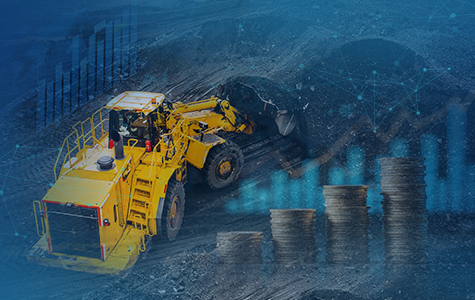The integration of artificial intelligence (AI) into the mining sector is not just a technological advancement; it is a transformative shift poised to redefine the industry. The AI in Mining and Natural Resources Market Size is valued at USD 4.6 billion in 2023 and is predicted to reach USD 20.3 billion by the year 2031 at a 20.5% CAGR during the forecast period for 2024-2031.As mining companies grapple with increasing environmental pressures, fluctuating market demands, and the need for operational efficiency, AI emerges as a powerful ally. From uncovering untapped mineral resources to enhancing safety and reducing carbon footprints, AI's applications are multifaceted and impactful. In 2025, these cutting-edge innovations promise to elevate the mining industry to unprecedented levels of productivity and sustainability. This blog delves into the most exciting AI-driven trends set to revolutionize mining operations in the coming year.The mining industry is on the brink of a new era, with artificial intelligence (AI) driving innovation and efficiency like never before. In 2025, AI technologies are poised to redefine the way resources are explored, extracted, and managed, addressing longstanding challenges while opening up new possibilities for sustainable operations.
.jpg)
1. Advanced Mineral Exploration
AI-driven mineral exploration continues to evolve, with 2025 seeing more precise and efficient methods. Machine learning models are now integrating geospatial data, satellite imagery, and historical exploration records to pinpoint untapped mineral deposits. This innovation reduces the time and costs associated with traditional exploration while enhancing accuracy. Companies like KoBold Metals are leveraging AI to locate rare earth elements crucial for renewable energy technologies.
2. Autonomous Mining Equipment
Autonomous vehicles and equipment are becoming more sophisticated, with AI enabling real-time decision-making and adaptability. From autonomous haul trucks to intelligent drilling systems, these machines operate seamlessly in hazardous environments, reducing risks to human workers. BHP and Rio Tinto are expanding their fleets of autonomous trucks, incorporating AI for route optimization and fuel efficiency.
3. Predictive Maintenance and Asset Management
In 2025, predictive maintenance systems powered by AI are expected to become more prevalent across mining operations. By analyzing sensor data and historical performance records, these systems can predict equipment failures with remarkable accuracy. This minimizes downtime, reduces maintenance costs, and extends the lifespan of critical machinery. Anglo American’s AI-powered asset management solutions exemplify this trend.
.jpg)
4. Real-Time Monitoring for Environmental Compliance
AI tools are increasingly used to monitor environmental impact in real time. By analyzing data from IoT sensors, drones, and satellite imagery, AI systems can detect potential environmental risks such as water contamination or tailings dam instability. Companies like Vale are leading the way, using AI-powered drones to ensure compliance with environmental regulations and enhance sustainability practices.
5. AI-Enhanced Ore Processing
Ore processing is becoming more efficient with AI systems that optimize the separation and refining of minerals. AI algorithms analyze ore grades in real time, adjusting processing parameters to maximize recovery rates and minimize waste. This technology is particularly valuable in processing low-grade ores, making mining operations more sustainable and cost-effective.
6. Carbon Footprint Reduction
AI is playing a critical role in helping mining companies meet their sustainability goals. From optimizing energy usage to reducing greenhouse gas emissions, AI-driven solutions are making mining operations greener. For example, AI models are being used to design energy-efficient mine layouts and optimize the use of renewable energy sources.
7. Workforce Augmentation and Training
AI-powered tools are enhancing workforce capabilities by providing real-time insights and recommendations. Virtual reality (VR) and augmented reality (AR) systems integrated with AI are used for training workers, ensuring they are prepared for the latest technologies and safety protocols. These advancements improve operational safety and efficiency.
8. Digital Twin Technology
Digital twins—virtual replicas of physical assets—are gaining traction in mining. Powered by AI, digital twins provide real-time simulations of mining operations, enabling better decision-making and planning. They allow mining companies to test scenarios and optimize processes without disrupting actual operations. Companies like Siemens are at the forefront of implementing this technology.
9. AI in Community Engagement
Mining companies are using AI to improve community relations and address stakeholder concerns. AI-powered sentiment analysis tools help companies understand and respond to public opinion, ensuring transparent and inclusive communication. This fosters trust and strengthens the social license to operate.
10. Enhanced Supply Chain Management
AI is transforming supply chain operations by optimizing logistics and inventory management. Predictive analytics tools enable companies to anticipate demand and streamline the supply chain, reducing costs and improving reliability. AI-driven solutions also enhance the traceability of minerals, ensuring ethical sourcing practices.
.jpg)
Looking Ahead
As 2025 unfolds, the integration of AI in mining is set to reach new heights. From improving efficiency and safety to advancing sustainability and community engagement, AI is reshaping the industry. By embracing these cutting-edge technologies, mining companies can unlock unprecedented opportunities while addressing critical global challenges.


























































We will verify and publish your comment soon.